‘I publish great content, but nobody finds it.’ We hear this frustration from WordPress users all the time. We felt the same way when we started our first blog, watching our posts disappear into the vast ocean of internet content because we didn’t understand SEO.
Fast-forward to today, and we’ve built multiple successful WordPress websites that rank well in Google. Along the way, we discovered that good SEO isn’t about complex technical tricks—it’s about following a proven system that works.
In this complete guide, we’ll share our step-by-step process for optimizing WordPress sites for search engines. Whether you’re just starting out or want to improve your existing site’s rankings, you’ll find everything you need to know about WordPress SEO—explained simply.
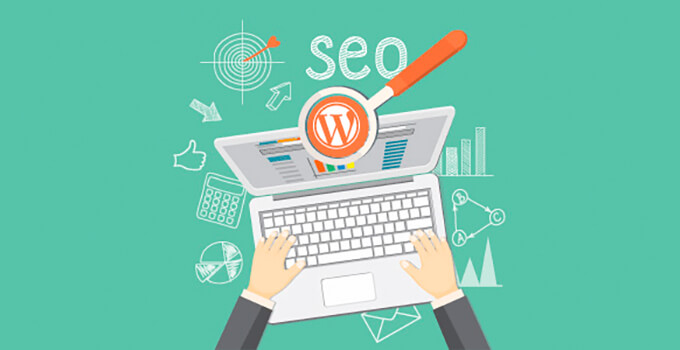
You have probably heard that WordPress is SEO-friendly, and that is true. This is why a lot of people choose WordPress to start a blog or a website.
WordPress is built with clean code that follows SEO best practices, making it easier for search engines to understand and index your content.
However, while WordPress provides a solid foundation, there is still work to be done to maximize your website’s visibility and attract organic traffic.
This guide provides a comprehensive roadmap to boost your WordPress SEO with actionable strategies you can put into practice immediately.
To help you navigate this in-depth guide, we have created a handy table of contents below:
Table of Contents
Introduction
The Basics of WordPress SEO
- Check your site’s visibility settings
- Using SEO-friendly URL structure in WordPress
- WWW vs non-WWW in URLs
The Best WordPress SEO Plugin
- Choosing the Best WordPress SEO plugin
- Add XML sitemaps in WordPress
- Add your site to Google Search Console
- Optimizing your blog posts for SEO
- Doing keyword research for your website
- Optimizing your website for local SEO
WordPress SEO Best Practices
- Properly using categories and tags in WordPress
- Make internal linking a habit
- Add schema markup and rich snippets
- Optimize WordPress comments
- NoFollow external links in WordPress
- Full posts vs summaries (excerpts)
Speed and Security for WordPress SEO
- Optimize your site’s speed and performance
- Optimizing images in WordPress for SEO
- Security and safety of your WordPress site
- Start using SSL/HTTPS
Finally, see more SEO tools and resources to take your WordPress SEO even further.
Introduction
We know the idea of optimizing for WordPress SEO can be intimidating for beginners, especially if you are not a tech geek.
But don’t worry, it does not have to be complicated. Start here to learn the basics, and then you can start applying them to your own website:
What Is SEO?
SEO is an acronym that stands for Search Engine Optimization. It’s a strategy used by website owners to increase their visibility online and attract more visitors by ranking higher in search engine results, particularly on Google.

Think of SEO like organizing a library. Just as books need a clear system to help readers find them, your website needs to be organized so search engines can find and recommend your content when people search for related topics.
Search engine optimization is not about tricking Google or gaming the system. It’s actually about creating a well-structured website with optimized code, clear formatting, and valuable content.
When people search the web for topics you write about, these optimization efforts help your content appear higher in search results, leading to more visitors finding your website naturally.
Why SEO Is Important
Search engines are often the biggest source of traffic for most websites.
Google and other search engines use advanced algorithms to understand and rank pages appropriately in search results. However, those algorithms are not perfect, they still need your help to understand what your content is about.
We’ve seen countless examples where unoptimized content struggles to rank, even when it’s valuable and well-written. If your content isn’t properly optimized, search engines won’t know how to rank it.
This means when people search for topics you write about, your website may not appear in the search results, causing you to miss out on valuable traffic.
Based on our experience, we believe it’s essential for all business owners to make their websites search engine friendly. This simple investment in SEO can dramatically increase your visibility online and help you reach more potential customers.
Basics of WordPress SEO
SEO can get technical, but it does not have to be. Just learning a few basic WordPress SEO tips to optimize your site can give you a noticeable boost in your website traffic.
You don’t have to be a tech genius to use the techniques below. If you are already using WordPress, then you’ve got what it takes!
Let’s get started optimizing your website.
Note: If you find that optimizing your website for SEO is too difficult, or you just don’t have enough time, then you can hire the experts at WPBeginner Pro Services to do it for you.
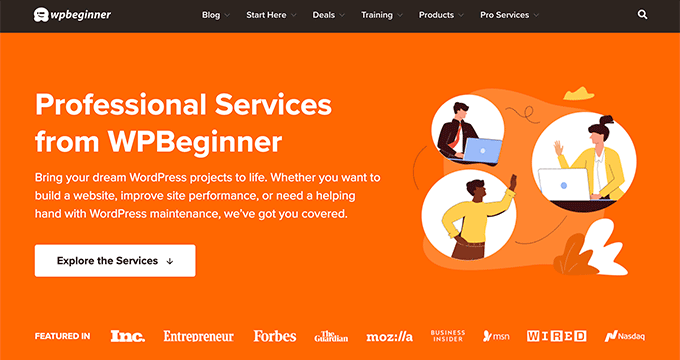
We offer WordPress SEO services to help grow your website traffic at affordable pricing. The service includes AIOSEO plugin setup, on-page optimization, Google Analytics with MonsterInsights setup, keyword research, and more.
Check Your Site’s Visibility Settings
WordPress comes with a built-in option to hide your website from search engines. This option gives you time to work on your website before it is ready to go public.
However, sometimes, this option can get checked accidentally, and it makes your website unavailable to search engines.
If your website is not appearing in search results, then the first thing you need to do is to make sure that this option is unchecked.
Simply log in to the admin area of your WordPress site and visit the Settings » Reading page.

You need to scroll down to the ‘Search Engine Visibility’ section and make sure that the box next to ‘Discourage search engines from indexing this site’ is unchecked.
Don’t forget to click on the ‘Save Changes’ button to store your changes.
Using SEO-Friendly URL Structures in WordPress
SEO-friendly URLs contain words that clearly explain the content of the page, and they are easy to read by both humans and search engines.
Some examples of SEO-friendly URLs are:
https://www.wpbeginner.com/how-to-install-wordpress/https://www.wpbeginner.com/common-wordpress-errors-and-how-to-fix-them/
Notice that these URLs are readable, and a user can guess what they will see on the page just by looking at the URL text.
So, what does a non-SEO friendly URL look like?
https://www.wpbeginner.com/?p=10467
http://example.com/archives/123
Notice that these URLs use numbers unrelated to the content, and a user cannot guess what they will find on the page by looking at the URL.
Using an SEO-friendly permalink structure improves your chances of getting better positions in search results.
Here is how you can check and update your WordPress site’s permalink structure.
You need to visit the Settings » Permalinks page. Select the post name option and then click on the ‘Save Changes’ button to store your settings.
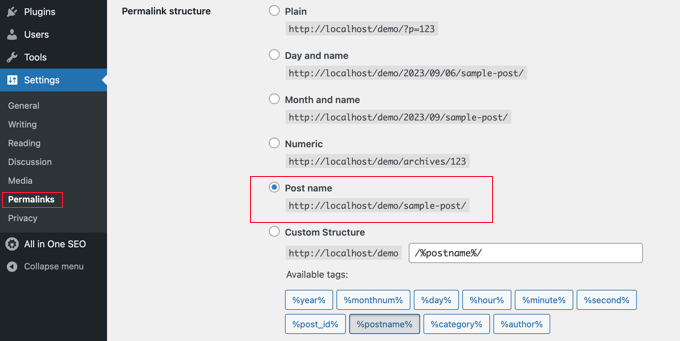
For more detailed instructions take a look at our guide on what is an SEO-friendly URL structure in WordPress.
Note: If your website has been running for more than 6 months, then please don’t change your permalink structure unless you are using the numbers option. If you are using Day and Name or Month and Name, continue using that.
By changing your permalink structure on an established site, you will lose all of your social media share counts and run the risk of losing your existing SEO ranking.
If you must change your permalink structure, then hire a professional so they can set up proper redirects. You will still lose your social share counts on the pages.
WWW vs. non-WWW
If you are just starting out with your website, then you need to choose whether you want to use www (http://www.example.com) or non-www (http://example.com) in your site’s URL.
Search engines consider these to be two different websites, so this means you need to choose one and stick to it.
You can set your preference by visiting the Settings » General page. Add your preferred URL in both the ‘WordPress Address’ and ‘Site Address’ fields.
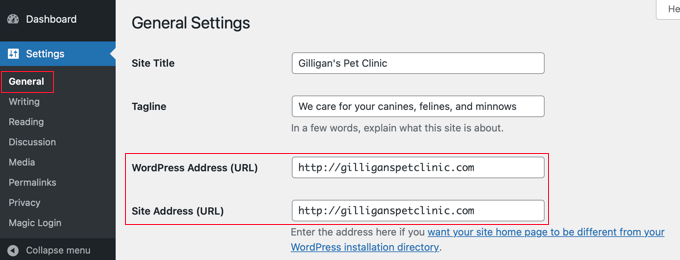
Despite what someone else might say, from an SEO standpoint, there is no advantage to using one or another.
For more detailed information on this topic, take a look at our guide on www vs non-www – which is better for WordPress SEO.
The Best WordPress SEO Plugin
One of the best things about WordPress is that there is a plugin for everything, and SEO is no exception. There are thousands of options, which makes it harder for beginners to choose the best WordPress SEO plugin.
Instead of installing separate plugins for individual SEO tasks, we will help you choose the best WordPress SEO plugin that does it all, and it is 100% free.
Choosing the Best WordPress SEO Plugin
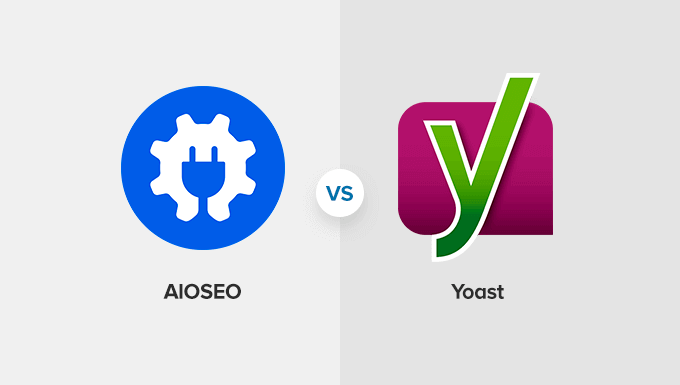
When it comes to choosing the best WordPress SEO plugin, you will most likely narrow your choices down to the two most popular solutions: All in One SEO (AIOSEO) or Yoast SEO.
In our experience, premium SEO plugins like these are worth it for most websites, although if you are on a budget, both solutions offer free versions that let you get started.
AIOSEO is the original WordPress SEO plugin that is used on over 3 million websites.
This is the plugin that we use on the WPBeginner website.
It comes with powerful features to automate WordPress SEO, including TruSEO on-page analysis, rich snippets schema markup, social media integrations, breadcrumb navigation, advanced eCommerce SEO support for WooCommerce, local SEO, internal link assistant, and much more.
Simply put, AIOSEO handles all of the technical SEO optimization for your WordPress site.
In this tutorial, we will be using AIOSEO for screenshots and examples.
For more details, you can see our complete guide on how to set up All In One SEO for WordPress.
We used to use Yoast SEO, but we switched to All in One SEO because it is innovating faster and has more powerful features. For more details, see our guide on the reasons why we switched from Yoast to AIOSEO.
Add XML Sitemaps in WordPress
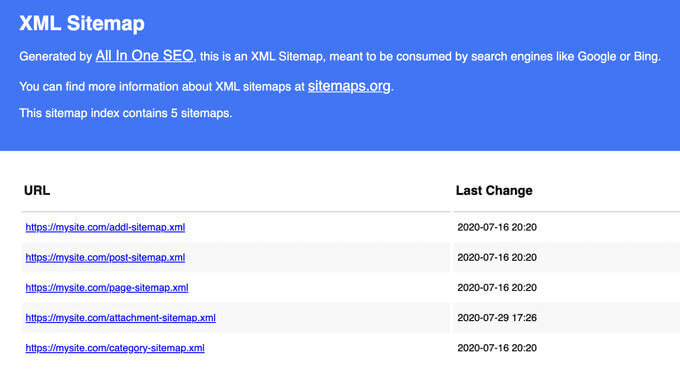
An XML sitemap is a specially formatted file that lists every single page on your website. This makes it easy for search engines to find all of your content.
While adding an XML sitemap does not boost your site’s search rankings, it does help search engines find the pages quickly and start ranking them.
If you are using the AIOSEO plugin, then it will automatically create an XML sitemap for you. To find your sitemap, just go to this URL (don’t forget to replace example.com with your own domain name):
http://example.com/sitemap.xml
We will show you how to submit your XML sitemap to Google in the next step.
Add Your Site to Google Search Console
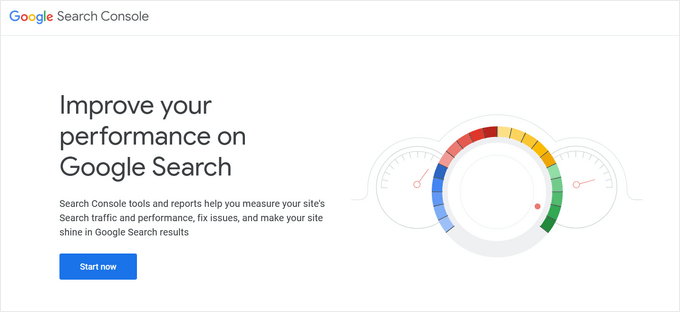
Google Search Console, also known as Webmaster Tools, is a set of tools offered by Google that allows website owners to see how their content is seen by the search engine.
It provides reports and data to help you understand how your pages appear in search results. You also get to see the actual search terms people are using to find your website, how each page appears in the search results, and how often your pages are clicked.
All this information helps you understand what is working on your site and what is not. You can then plan your content strategy accordingly.
Google Search Console also alerts you when there is something wrong with your website, like when search crawlers are unable to access it, find duplicate content, or restricted resources.
If you are using AIOSEO, then you can follow this guide on how to add Google Search Console.
If you are not using AIOSEO, then you can watch our video that shows an alternative way:
You can also read this step-by-step guide on how to add your WordPress site to Google Search Console.
Once you have added your website to Google Search Console, click on ‘Sitemap’ from the left menu and then paste the last part of the sitemap URL.
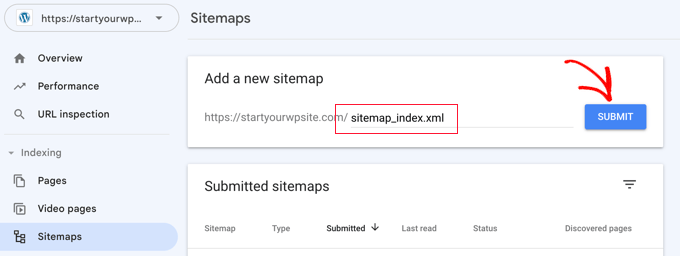
Don’t forget to click on the ‘Submit’ button to save your changes.
Google Search Console will now check your sitemap and use it to improve your website’s crawling.
Once you have successfully added your sitemap, it will appear as pending. It does take Google some time to crawl your website.
After a few hours, you will be able to see some stats about your sitemap. It will show you the number of links it found in your sitemap, how many of them got indexed, the ratio of images and web pages, and more.
We recommend that you check your Search Console at least monthly to gather insights and to see your website’s SEO progress.
Update: The AIOSEO team has Google Search Console integration that lets you have a full search statistics dashboard right inside your WordPress site.
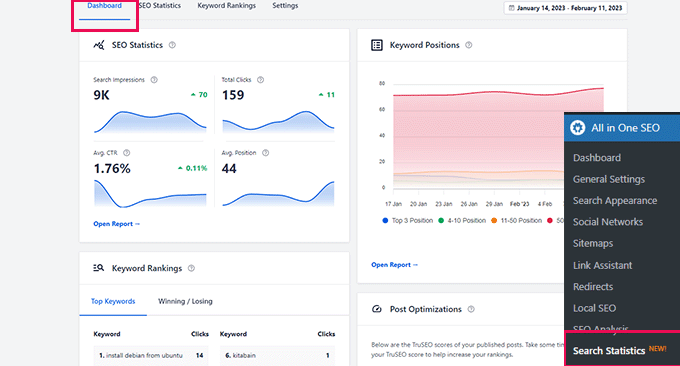
Aside from Google Search Console, we also recommend that you submit your website to other popular search engines like Bing, Yahoo, DuckDuckGo, and others.
Along with various search consoles, you should also use MonsterInsights to analyze your organic traffic. MonsterInsights makes it easy to see insights from Google Analytics right from your WordPress dashboard.
Follow this tutorial to learn how to install Google Analytics in WordPress with MonsterInsights.
Optimizing Your Blog Posts for SEO
Often, beginners make the mistake of thinking that installing and activating a WordPress SEO plugin is all that is needed. SEO is an ongoing process that you must keep up with if you want to see maximum results.
All top SEO plugins allow you to add an SEO title, meta description, and focus keyword to every blog post and page. It also shows you a preview of what users will see when they Google your website.
We recommend that you optimize your title and description to get maximum clicks in search engine results.
When writing your blog post, simply scroll down to the SEO section and take full advantage of it.
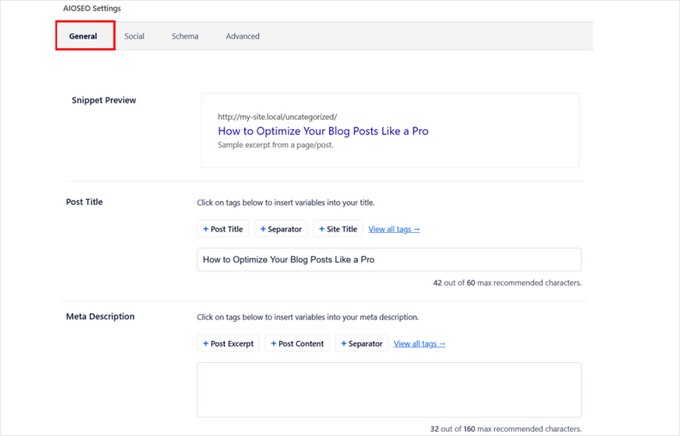
If you are wondering how to choose a focus keyword or focus keyphrase or write a good title or meta description, then we have covered it in detail in our beginner’s guide to optimizing your blog posts for SEO.
We also recommend that you use SEO checker tools to analyze the strengths, weaknesses, and performance of your content as you write. This will highlight how you can improve the clarity, relevance, and user engagement of your blog posts as you write.
We highly recommend that you read it because on-page SEO is crucial for the success of your SEO strategy.
Doing Keyword Research for Your Website
Many beginners use their best guesses to figure out what topics people are looking for and what they should add to their blogs and websites.
It is like shooting an arrow in the dark. You don’t need to do that when you can use real data to find out what people are looking for.
Keyword research is a research technique used by content creators and SEO experts. It helps you discover words users enter into search engines to find content, products, and services in your industry.
You can then use those words and phrases on your website to get more search traffic.
There are a ton of keyword research tools (both free and paid) that you can use. We recommend using LowFruits, as it helps you discover low-competition keywords and even find out the keywords where your competitors are ranking.
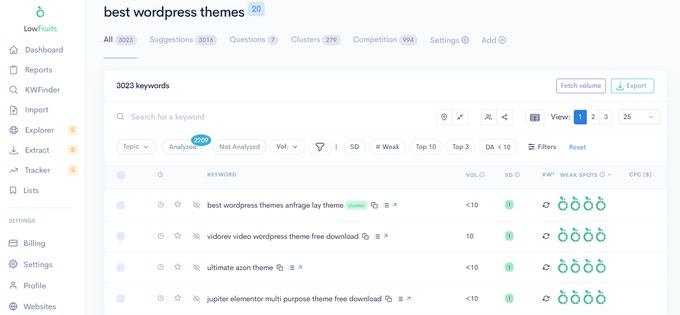
It also comes with a Keyword Clustering feature that can help you create SEO topic clusters. This can help build your authority and rank for more related keywords.
If you are looking for a free alternative, then you can use the WPBeginner Keyword Generator. It lets you instantly generate 300+ keyword ideas in a downloadable report, free of charge.
WPBeginner also has a free Keyword Density Checker, which allows you to enter your competitor’s URL to reveal which keywords they are optimizing for.
For more details, see our beginner’s guide on how to do keyword research for your WordPress website.
Optimizing Your Website for Local SEO
If your online store or business has a physical location, such as a restaurant, retail outlet, or regional office, then you also need to optimize it for local SEO. This will allow your website to be listed in local search results when users search for businesses like yours in their area.
For example, when someone searches for ‘Italian restaurants near me’, they will see relevant businesses near them on a list and map in the search results.
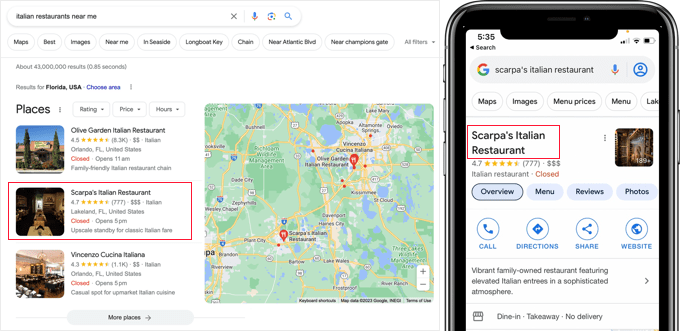
‘Shopping near me’ searches like these are increasing 100% globally year over year. (source) This means you will be losing valuable traffic if your business is missing from local search results.
The key factors that influence local search rankings include:
- Having a Google Business listing
- Displaying positive reviews from real customers
- Making sure your business information and content match the right keywords
- Ensuring that your name, business address, and phone number are consistent across all online platforms
- Your business is close to the searcher
Using local business schema markup on your website will help search engines understand your business information accurately.
The easiest way to add this structured data to your site is using All in One SEO (AIOSEO). Its premium Local SEO module lets you add location data, contact information, opening hours, maps with turn-by-turn directions, and much more.
And don’t worry if your business has multiple locations. Simply toggle the ‘Multiple Locations’ setting in AIOSEO to add local information for all of your stores or offices.
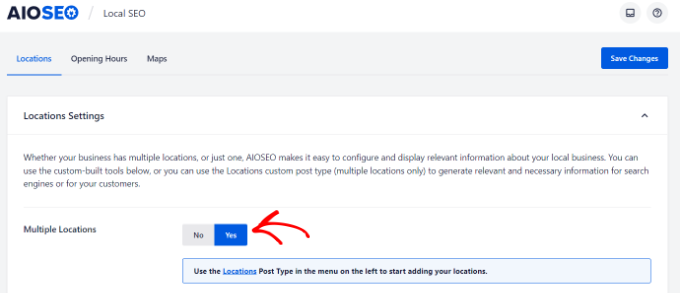
WordPress SEO Best Practices
If you follow the basics of WordPress SEO and use the best WordPress SEO plugin, then you will already be ahead of most websites.
However, if you want even better results, then you need to follow the WordPress SEO best practices below.
These are not too technical, and most will not even require you to touch any code. But they will make a big difference if you follow them.
Properly Using Categories and Tags in WordPress

WordPress allows you to sort your blog posts into categories and tags. This makes it easy for you to manage your content by topics, and for your users to find the content they are looking for.
Categories and tags also help search engines understand your website structure and content.
Often, beginners get confused about how to best use categories and tags. After explaining this to thousands of readers, here’s how we approach categories and tags.
Categories are meant for the broad grouping of your posts. If your blog was a book, then categories will be the table of contents.
For example, on a personal blog, you can have categories like music, food, and travel. Categories are hierarchical, so you can add child categories to them.
On the other hand, tags are more specific keywords that describe the contents of an individual post. For example, a blog post filed under the food category can have tags like salad, breakfast, and pancakes. Think of these as index sections in a textbook.
For more on this topic, see our guide on categories vs. tags and SEO best practices for sorting your content.
By using categories and tags properly, you make it easy for your users to browse your website. Since it is easy for users, it also makes it easier for search engines to browse your website.
You can learn more about optimizing your categories and tags for search in our guide on taxonomy SEO.
Make Internal Linking a Habit
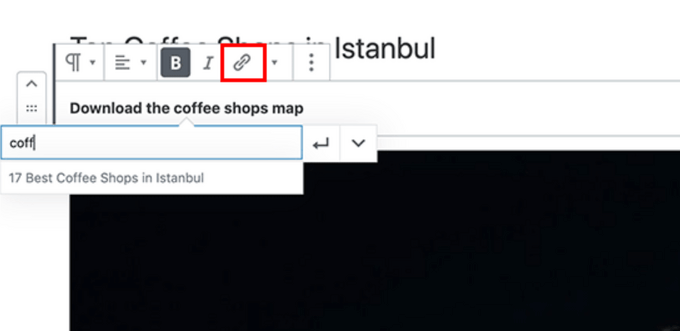
Search engines assign each page on your website a score called ‘page authority’. The recipe of this score is kept secret so that people can’t game the results. However, the most common signals of authority are links.
This is why it is important that you link to your own content from your other blog posts and pages.
You should make it a habit to interlink your own posts whenever possible. If you have multiple authors, then you can create a pre-publish blog post checklist that requires them to interlink at least 3 other blog posts.
This will help you boost your pageviews, increase the time users spend on your site, and ultimately improve the SEO score of your individual blog posts and pages.
Adding links to your website can take a lot of time and it is easy to forget to link to something important. You can make internal linking easier by using an SEO links plugin for WordPress.
For example, the team at All in One SEO created a feature called WordPress Link Assistant.
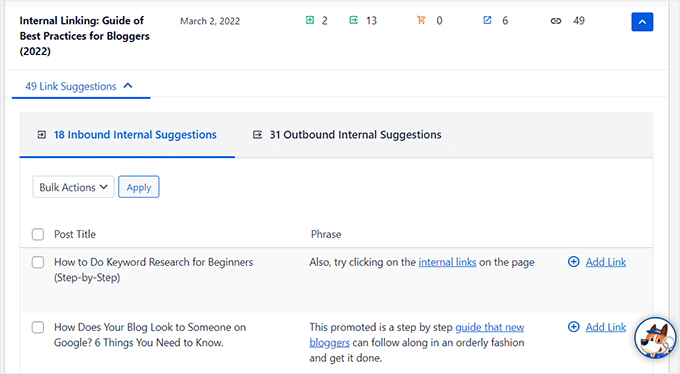
Link Assistant automatically crawls the links on your WordPress site and gives you relevant internal linking suggestions that you can add to your content in 1-click.
Simply put, it automates the process of bulk adding internal links which is a huge time saver.
You can learn more about it in our list of the best internal linking plugins for WordPress. You may also want to read our internal linking guide with best practices for SEO.
Related: All in One SEO has also released the free Broken Link Checker plugin. It automatically scans all of your internal links to make sure they are working correctly. If broken links are found, then you can quickly fix the URLs right inside the plugin.
Schema Markup and Rich Snippets (FAQ Schema, Reviews, and More)
Have you ever wondered why certain website listings stand out more in Google search results? Perhaps they have star ratings next to them, or they are much larger with FAQ questions below them.
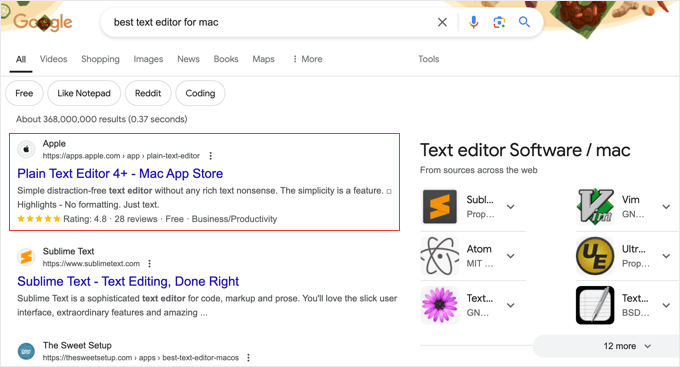
There are different ways that Google features the most relevant results at the top of the search listings. These include Google answer boxes, rich snippets, and AI overviews.
The best way to get rich snippets on Google and other search engines is using schema markup. Custom schema helps your website stand out so you can get a better click-through rate (CTR). In turn, this ends up helping your WordPress site rank higher in SEO.
Now, you might be wondering how schema markup really works.
In plain English, schema markup is a special type of HTML code that you can add to your WordPress website to tell search engines more about your content.
For instance, you can tell the search engines that a particular page is a blog post, a recipe, a FAQ, a news article, or a product page in your online store. Search engines can then use this data to display rich results.
Now, the good news is that most website owners don’t actually add code to add schema markup.
Powerful WordPress SEO plugins like AIOSEO already do this for you by adding these settings in your post and page editor. You can customize the schema markup for each post further. We have covered more details on how to do this in our beginner’s guide on how to use rich snippets.

For example, if you are looking to add FAQ schema in WordPress, then all you need to do is select the FAQ schema template and add the questions there. AIOSEO behind the scenes will add the JSON+LD schema markup code on your website (without you doing any technical work).
Once this is added, your website listing will stand out more in Google like this.
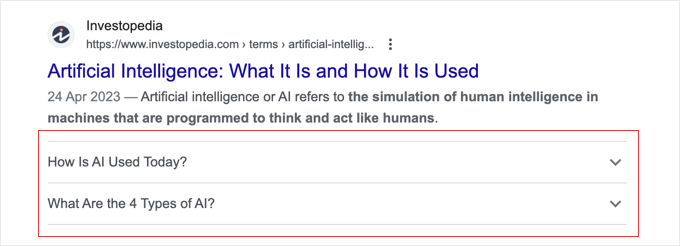
You can also use a similar technique to add recipe schema, product schema, event schema, and other types of schema markup.
We always recommend our users take advantage of the custom schema markup tool in AIOSEO to make your website stand out so you can improve your SEO rankings.
Optimize WordPress Comments

Comments can be a strong indication of user engagement on your website. Engaged users mean more links back to your site, more traffic, and improved SEO.
However, you need to make sure that your comments are real and not spam. Spammers submit comments with bad links, which could affect and even ruin your search rankings.
This is why we recommend everyone to start using Akismet. It is one of the two plugins that come pre-installed with every WordPress site, and it helps you combat comment spam.
If Akismet alone is unable to handle comment spam, then see these tips and tools to combat comment spam in WordPress.
If your blog posts attract a lot of genuine, spam-free comments, then you should pat yourself on the shoulder for building such an engaging website!
However, too many comments on a post can make it load slower, which also affects your search engine rankings. (Keep reading below to find out more about how speed affects SEO.)
To prepare your website so that it can handle the burden that comments put on your server and speed, you can split comments into multiple pages. See our tutorial on how to paginate comments in WordPress.
If you would like to get more comments on your site, then check out these ways to get more comments on your WordPress blog posts.
NoFollow External Links in WordPress
As mentioned above, links help search engines decide which pages are important. When you link to a website, you are passing some of your site’s SEO score to that link. This SEO score is called ‘link juice’.
For good search rankings, you need to make sure that you are getting more link juice from other websites than you are giving away.
Adding the ‘nofollow’ attribute to external links (links to websites that you don’t own) instructs search engines not to follow those links. This helps you save link juice.
A normal external link looks like this in HTML:
<a href="http://example.com">Example Website</a>
An external link with the nofollow attribute looks like this:
<a href="http://example.com" rel="nofollow">Example Website</a>
By default, WordPress does not come with an option to make links nofollow. However, if you are using the AIOSEO plugin, it makes it easy for you.
When you add a link, simply click the Add “nofollow” to link option.
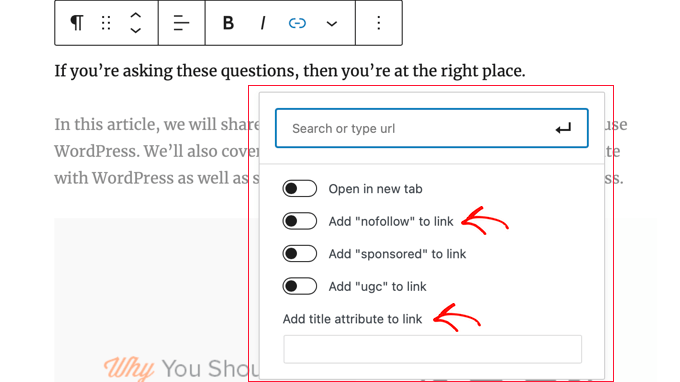
For more details and alternate methods, see our guide on how to add nofollow links in WordPress.
Full Posts vs. Summaries or Excerpts
WordPress displays and links to your posts from a number of pages, such as the home page, category archive, tags archive, date archive, author pages, and more.
By default, it shows the full article content on all these pages. This affects your site’s SEO, as search engines may find it to be duplicate content. Full articles also make your archive pages load slower.
Showing full articles everywhere also affects your page views. For example, users who subscribe to your RSS feed will be able to read the full article in their feed reader without ever visiting your website.
The easiest way to solve this is by showing summaries or excerpts instead of full articles.
You can do this by going to Settings » Reading and selecting excerpt.
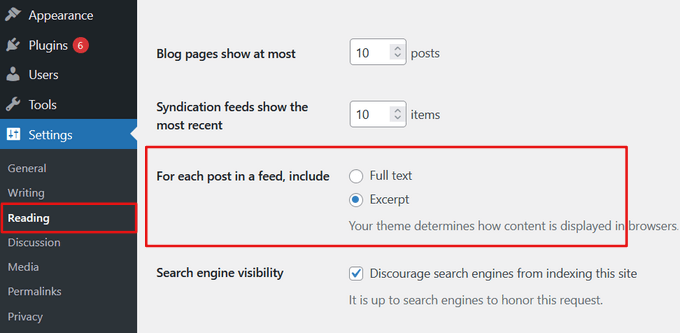
For detailed instructions, see our guide on how to customize WordPress excerpts without coding.
Speed and Security for WordPress SEO
Even if you follow all the WordPress SEO tips and best practices above, if your site is slow or gets taken down by a hacker, then your search engine rankings will take a big hit. This is known as ‘technical SEO‘.
Here is how to prevent your site from losing search engine traffic due to slow performance or lax security.
Optimize Your Site’s Speed and Performance
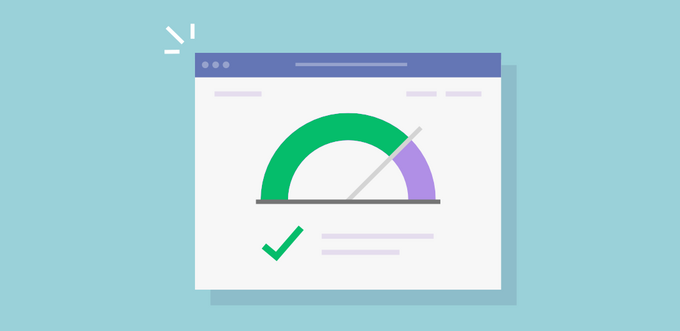
Research shows that in the internet age, the average human attention span is shorter than that of a goldfish.
Web usability experts believe that users decide whether they want to stay or leave within a few seconds of visiting a website.
That means that as a website owner, you only have a few seconds to present your content and engage users. You don’t want to waste this precious time making your visitor wait for your website to load.
Because user experience is so important, search engines like Google prioritize faster websites in their results. In other words, faster websites rank higher on Google.
To improve your website speed, you must have a fast WordPress hosting provider like SiteGround or Hostinger (Bonus: Get 79% off with our Hostinger coupon code!)
After that, you need to install a caching plugin and follow our ultimate guide to speed up WordPress.
Optimizing Images in WordPress for SEO
Images are more engaging than text, but they also take more time to load. If you are not careful with image sizes and quality, then they can slow down your website.
You need to make sure that you use images that are optimized to load faster. See our guide on how to speed up WordPress by optimizing images for the web.
Another trick you can use to optimize your images for search engines is to use a descriptive title and alt tags. These tags help search engines understand what your image is about. They also help users with visual impairment as their screen readers can read the alt text to them.
WordPress allows you to easily add titles and alt tags when you upload an image.
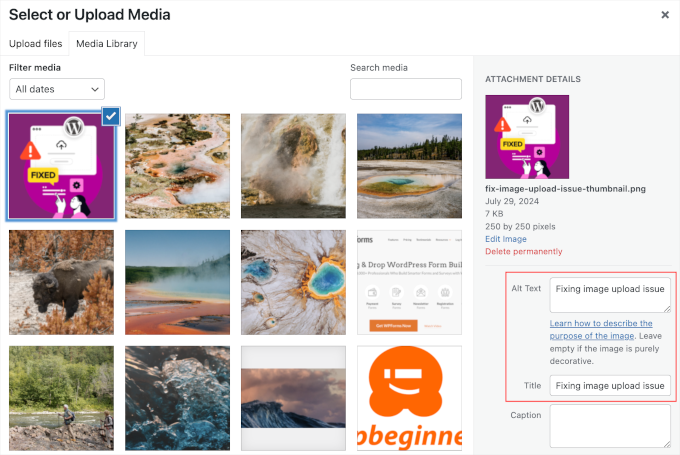
If you are a photographer or add a lot of images to your WordPress site, then you need to use a gallery plugin.
We recommend using the Envira Gallery plugin alongside AIOSEO. In our speed tests, we found it to be the fastest WordPress gallery plugin. It is also fully responsive and SEO-friendly out of the box.
For more tips, see our complete beginner’s guide to image SEO.
And if you have video content, that should be optimized as well. You can see our step-by-step guide on how to properly set up video SEO in WordPress for the details.
Security and Safety of Your WordPress Site
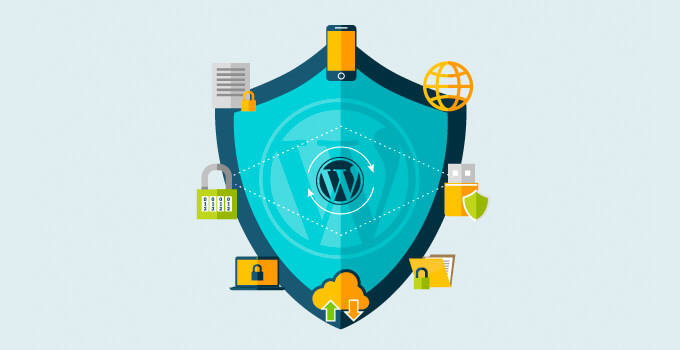
Each week, Google blacklists around 20,000 websites for malware and around 50,000 for phishing. When a site is blacklisted, it does not show up in any search results at all.
This means that the security of your WordPress site is crucial for good rankings. You don’t want all your hard work on SEO to go to waste if your site is compromised by a hacker.
The good news is that it is not that difficult to keep your WordPress site safe. Just see the step-by-step instructions in our ultimate WordPress security guide.
At WPBeginner, we currently use Cloudflare to protect our website against attacks and used Sucuri for many years. To see why we recommend these kinds of services, read our case study of how Sucuri helped us block 450,000 WordPress attacks in 3 months.
Start Using SSL/HTTPS
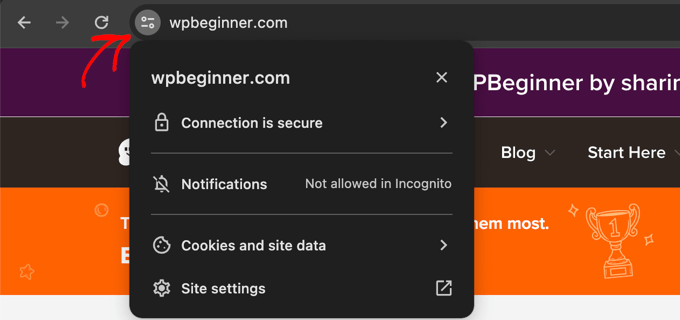
SSL (Secure Sockets Layer) is a technology that encrypts the connection between a user’s browser and the server they are connecting to. This adds an additional security layer to your WordPress site.
Websites secured with SSL are indicated by a padlock or ‘tune’ icon in the browser’s address bar. This makes your website more trustworthy, and it is required if you are running an online store with WordPress and processing sensitive payment information.
All top WordPress hosting companies offer free SSL certificates with Let’s Encrypt. See our guide on how to get a free SSL certificate for your website for more details.
If you want a premium wildcard SSL certificate or just a regular certificate with a security warranty, then we recommend using Domain.com.
Their SSL certificates come with a minimum of $10,000 security warranty and up to $1.75 million security warranty. You also get a TrustLogo site seal to display on your site for added credibility.
Video Tutorial
If you would prefer written instructions, then just keep reading.
More SEO Tools and Resources
Once you get the hang of WordPress SEO best practices, you will want to take your skills even further to get ahead of your competition.
We have compiled a list of the best WordPress SEO plugins and tools to boost your SEO.
Our top 5 recommendations for the best WordPress SEO plugins and tools are:
- AIOSEO, also known as All in One SEO, is the best WordPress SEO plugin used by over 3 million websites. There is a free version of AIOSEO that is available, too.
- Semrush is our pick for the best keyword research and competitor analysis tool. Although it is pricey, it is really that powerful and is the #1 choice for Pros. (Free Alternatives: WPBeginner Keyword Generator and Keyword Density Checker.)
- MonsterInsights is the best Google Analytics plugin that helps you see all the important stats in one place. Remember, you can’t improve what you can’t measure. Over 3 million websites use MonsterInsights. There is a free MonsterInsights Lite version available as well.
- Lowfruits is a powerful keyword research tool that will help you track your Google rankings and identify low-competition keywords that are easier to rank for. It can help you outrank your competitors and drive organic traffic to your site.
- SEOBoost is an AI-powered writing assistant that helps you write high-ranking content. It identifies the best keywords to use in your blog posts and analyzes your content for keyword density, readability, and relevance to boost your on-page SEO.
If you are ready to try some more advanced techniques, then you can also check out our archive of WordPress SEO articles. Below are some hand-picked guides that you might find helpful:
- WordPress SEO audit checklist to boost your rankings
- How to create an SEO report for your WordPress site
- How to add IndexNow in WordPress to speed up SEO results
- The WordPress SEO crawl budget problem and how to fix it
- How to get Google Sitelinks for your WordPress site
- How to create a table of contents in WordPress to boost SEO rankings
- How to add RSS sitemap in WordPress to improve SEO rankings
- How to submit your WordPress site to Google News
- How to redirect a page or URL in WordPress
- How to do a full-site redirect in WordPress
- Voice Search SEO – how to optimize your WordPress blog for voice search
We hope this article helped you learn how to properly optimize your WordPress site for SEO. Go ahead and implement a few of these WordPress SEO tips, and you should see an increase in your traffic within a few months as the search engines process your changes.

Oyekanmi olamilekan
You guys never disappointed me when it comes to building a website that meet expection. Your content are rich and make me keep my clients.
WPBeginner Support
Glad you found our guide helpful
Admin
Sora
Thanx a lot for detailed article. I’ve a question. I recently started a blog about travel and thinking about wordpress seo plugin. Which one is better: AIOSEO or Yoast Seo?
WPBeginner Support
For our recommendations, you would want to take a look at our list below:
https://www.wpbeginner.com/showcase/9-best-wordpress-seo-plugins-and-tools-that-you-should-use/
Admin
Amber German
I just wanted say that you’re brilliant. I’ve recently switched my blog from a free Blogger account to a self hosted WordPress account, based on your recommendations and that I knew it would be better for my blog. I love seeing your explanations for all of the steps and options for building a website or blog, and then seeing them in action right here on yours. It helps the learning process. It’s definitely not as simple as I’d imagined (200 simple steps equals a lot more complication), but thanks to this site, I know I’ll get there eventually. I literally couldn’t do it without you.
WPBeginner Support
Glad you found our content helpful
Admin
Andre Lima
Perfect article. It helps me a lot and I am able to get a better SEO score. I have a doubt my site is without a WWW prefix. But I am able to reach both (with and without WWW). My configuration in wordpress is without WWW. Is there any issues for Search Engines to keep the configuration like that?
WPBeginner Support
There should not be an issue with that, you may want to ensure with your host that you are redirecting to the version you would prefer your site to be found.
Admin
Mireia
This is amazing, thanks!
WPBeginner Support
Glad you found it helpful
Admin
Rustom Gutierrez
Very useful content. I like the whole article. I will apply it.
WPBeginner Support
Glad you found our guide helpful
Admin
Kate
Super! I had a lot of necessary information from this article, thank you so much.
WPBeginner Support
Glad you found our guide helpful
Admin
Shiv Raj
Thanks for the awesome tips
WPBeginner Support
You’re welcome, glad our guide was helpful
Admin
Chinny Ivy
You make our lives easier. Thank you. This was very helpful
WPBeginner Support
Glad our guide was helpful
Admin
Veting
Will be helpful to share the link to my site?
WPBeginner Support
Sharing links to your site can help people fin d your site.
Admin
James Emmanuel
Great article, Thanks for nicely analised steps. I will consider following them one by one for my post.
Keep up the Good work.
WPBeginner Support
Glad you found our content helpful
Admin
shoaib sohail
great article, helped me a lot, and made a lot of changes!
thanks guys! keep up the good work!
WPBeginner Support
Glad our guide was helpful
Admin
Trina
Literally the best article I’ve read since deciding to start a blog. It took me hours to read but I took so many notes and can’t wait to apply everything you covered. Huge credit to you for making this an interesting and very helpful article. I will be back for more!
WPBeginner Support
Glad our guide was helpful
Admin
Azeem Haq
Awesome work! Very detailed article. Thank you.
WPBeginner Support
You’re welcome
Admin
Nisar Ahmad
Excellent and very helpful information.
WPBeginner Support
Glad you felt our guide was helpful
Admin
Malati Shankar
Such an in-depth information. As a new blogger this kind of posts are really encouraging and motivating.
Thank you and regards.
WPBeginner Support
Glad our guide is helpful
Admin
Sumedha Dutta
Thanks a ton for this really informative and in-depth article. Means a lot to new bloggers such as myself.
WPBeginner Support
You’re welcome
Admin
Adam Joseph
In the section which mentions permalinks, I can’t follow the steps because the option is not available in the admin menu. Is this option only available for Wordpress Business Accounts? I’ve got a Premium Account “only”.
WPBeginner Support
Our guides are for WordPress.org, you can see our comparison of the two platforms in our article below:
https://www.wpbeginner.com/beginners-guide/self-hosted-wordpress-org-vs-free-wordpress-com-infograph/
Admin
Riyanna
Thankyou for this very wonderful and informative article. As a beginner the informations shared here helped me a lot to gain a much better understanding on Wordpress SEO. Thank you and wishing you all the very best in all your future endeavors…
WPBeginner Support
Glad you found our content helpful
Admin
Mohd Noman Khan
Thank you so much it was very helpful.
WPBeginner Support
You’re welcome
Admin
Max Lai
Thank you so much! Very usefull
WPBeginner Support
You’re welcome, glad our post was helpful
Admin
AbdulRaheem
Nice and handy article. This website has been my key reference for the past 6-years and the contents still looks new.
WPBeginner Support
Glad you continue to find our content helpful
Admin
Ogbonnia Victor
This is awesome
I never knew I could find such a helpful content
Thanks
WPBeginner Support
Glad our guide was helpful
Admin
Sunday
Thanks for this information. It clear and easy to understand.
WPBeginner Support
Glad our guide was helpful
Admin
Rashidah
A highly informative article (for a digital dummy like me); thank you!
This post is jam packed with useful pointers. Readers will find valuable info covering many topics.
I used to try learning WordPress from everywhere (I intend to start blogging). That was confusing but since I joined WPBeginner FB page, learning is so much easier (it is like a one-stop learning centre).
Keep up the good work, Team!
WPBeginner Support
Glad you found our content and Facebook group helpful
Admin
Muhammad Usman
Very Helpful site
WPBeginner Support
Thank you
Admin
Dhruvi Gohil
Thank you so much! This blog helps me a lot and even sort out the confusions I have till NOW!
WPBeginner Support
You’re welcome
Admin
Akaninyene
Clear and easy to follow. So helpful. Many thanks.
WPBeginner Support
You’re welcome, glad our guide was helpful
Admin
MANOJ CHITARA
as always great content great knowledge keep it up
WPBeginner Support
Thank you
Admin
Hannan Ahmed
wpbeginner is just amazing. Very clear concept, use common English words. Never seen this kind of helpful blog.
WPBeginner Support
Glad you found our guide helpful
Admin
Isaias Cuvula
I love this article, it’s very simple and clear!
SEO was an unknown world to me, with this article, I no longer feel lost! I will apply all of this advice. thank you
WPBeginner Support
You’re welcome, glad our guide could help clear up any confusion
Admin
Drivestreak
This is an awesome post. I have saved this url for future reference.
WPBeginner Support
Glad you found our post helpful
Admin
Wanja Wannbäck
Thanks so much for all the info has taught me lots.
WPBeginner Support
You’re welcome
Admin
Helen
Wow… just thank you!
WPBeginner Support
You’re welcome
Admin
zelmer william
Really Appreciate Thank you
WPBeginner Support
You’re welcome
Admin
nissi
It is very helpful. Thanks for sharing
WPBeginner Support
You’re welcome
Admin
Bijendra Patre
Very Informative for New blogger its really usefull.
WPBeginner Support
Glad you found our article helpful
Admin
Alberto
Thank your for this great content.
I’ll keep exploring and advertising it!
Cheers
WPBeginner Support
Glad you like our articles and thank you for sharing it to those who may need them
Admin
Sahil Ahuja
Mannnn. I have learned so much from your website. Let me know how can I ever pay you back. Not with real money of course
WPBeginner Support
Glad our guides have been helpful to you
Admin
leeken
very good article i read this article this is very useful article for SEO.
WPBeginner Support
Thank you, glad you like our article
Admin
David Mortimer
Another great article from wpbeginner! Thanks for the guidance, I am currently trying to improve SEO for my website. Two days ago I knew nothing about SEO but this has helped improve my understanding.
WPBeginner Support
You’re welcome, glad you liked our article and hope our guides continue to help you
Admin
Prabin
Awesome and great content . It’s the perfect blog to learn all A-Z about WP.
Loved it .
WPBeginner Support
Thank you, glad you’ve found our content helpful
Admin
Daleen
Hi
What is the difference between https and http and can I just put https in on my settings or do I need a plugin for that
Daleen
WPBeginner Support
You require an SSL certificate for HTTPS, you would want to take a look at our article here:
https://www.wpbeginner.com/wp-tutorials/how-to-add-ssl-and-https-in-wordpress/
Admin
Komal Tariq
How can I do good SEO for my online store website? Kindly guide me in this regard.
WPBeginner Support
Most of the recommendations in this article should still be able to help with a store but we will look into if we can include more specifics for stores in the future.
Admin
Abhay
I srarted my blog but I wasn’t getting traffic and after following you I am getting traffic not that much but yes people are coming.
WPBeginner Support
Glad our guide could help you improve your SEO
Admin
Mary J. Freese
If you are serious about increasing your website traffic, then you need to pay attention to the WordPress SEO best practices.
WPBeginner Support
Thanks for sharing how you feel, we hope our article helps people looking to improve their SEO
Admin
Angelia Vangiller
Always informative and interesting. My questions are always answered when I come to this site so it has become my go-to when I’m not sure what to do. Thank you!
WPBeginner Support
You’re welcome, glad our articles have been helpful
Admin
Kiran patil
Thank You For Guiding Us To Start Learning Wordpress.
WPBeginner Support
You’re welcome, glad you’ve found our guides helpful
Admin
Shaneen
Clear and concise, thank you. Very informative
WPBeginner Support
You’re welcome, glad you liked our article
Admin
Ankush Singla
Very good article. Learnt heaps from it.
WPBeginner Support
Thank you, glad you liked our guide
Admin